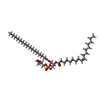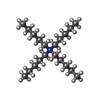+ Open data
Open data
- Basic information
Basic information
| Entry | Database: PDB / ID: 8fz7 | |||||||||||||||||||||||||||||||||||||||||||||||||||
|---|---|---|---|---|---|---|---|---|---|---|---|---|---|---|---|---|---|---|---|---|---|---|---|---|---|---|---|---|---|---|---|---|---|---|---|---|---|---|---|---|---|---|---|---|---|---|---|---|---|---|---|---|
| Title | TpeA bound closed MthK-A88F mutant in nanodisc | |||||||||||||||||||||||||||||||||||||||||||||||||||
 Components Components | Calcium-gated potassium channel MthK | |||||||||||||||||||||||||||||||||||||||||||||||||||
 Keywords Keywords | MEMBRANE PROTEIN / MTHK / TRANSPORT PROTEIN / ION CHANNEL / Blocker TpeA | |||||||||||||||||||||||||||||||||||||||||||||||||||
| Function / homology |  Function and homology information Function and homology informationmonoatomic cation transmembrane transporter activity / potassium ion transport / metal ion binding / identical protein binding / plasma membrane Similarity search - Function | |||||||||||||||||||||||||||||||||||||||||||||||||||
| Biological species |   Methanothermobacter thermautotrophicus (archaea) Methanothermobacter thermautotrophicus (archaea) | |||||||||||||||||||||||||||||||||||||||||||||||||||
| Method | ELECTRON MICROSCOPY / single particle reconstruction / cryo EM / Resolution: 2.88 Å | |||||||||||||||||||||||||||||||||||||||||||||||||||
 Authors Authors | Agarwal, S. / Nimigean, C.M. | |||||||||||||||||||||||||||||||||||||||||||||||||||
| Funding support |  United States, 1items United States, 1items
| |||||||||||||||||||||||||||||||||||||||||||||||||||
 Citation Citation |  Journal: Nat Chem Biol / Year: 2024 Journal: Nat Chem Biol / Year: 2024Title: Calcium-gated potassium channel blockade via membrane-facing fenestrations. Authors: Chen Fan / Emelie Flood / Nattakan Sukomon / Shubhangi Agarwal / Toby W Allen / Crina M Nimigean /    Abstract: Quaternary ammonium blockers were previously shown to bind in the pore to block both open and closed conformations of large-conductance calcium-activated potassium (BK and MthK) channels. Because ...Quaternary ammonium blockers were previously shown to bind in the pore to block both open and closed conformations of large-conductance calcium-activated potassium (BK and MthK) channels. Because blocker entry was assumed through the intracellular entryway (bundle crossing), closed-pore access suggested that the gate was not at the bundle crossing. Structures of closed MthK, a Methanobacterium thermoautotrophicum homolog of BK channels, revealed a tightly constricted intracellular gate, leading us to investigate the membrane-facing fenestrations as alternative pathways for blocker access directly from the membrane. Atomistic free energy simulations showed that intracellular blockers indeed access the pore through the fenestrations, and a mutant channel with narrower fenestrations displayed no closed-state TPeA block at concentrations that blocked the wild-type channel. Apo BK channels display similar fenestrations, suggesting that blockers may use them as access paths into closed channels. Thus, membrane fenestrations represent a non-canonical pathway for selective targeting of specific channel conformations, opening novel ways to selectively drug BK channels. #1:  Journal: Nature / Year: 2020 Journal: Nature / Year: 2020Title: Ball-and-chain inactivation in a calcium-gated potassium channel. Authors: Chen Fan / Nattakan Sukomon / Emelie Flood / Jan Rheinberger / Toby W Allen / Crina M Nimigean /    Abstract: Inactivation is the process by which ion channels terminate ion flux through their pores while the opening stimulus is still present. In neurons, inactivation of both sodium and potassium channels is ...Inactivation is the process by which ion channels terminate ion flux through their pores while the opening stimulus is still present. In neurons, inactivation of both sodium and potassium channels is crucial for the generation of action potentials and regulation of firing frequency. A cytoplasmic domain of either the channel or an accessory subunit is thought to plug the open pore to inactivate the channel via a 'ball-and-chain' mechanism. Here we use cryo-electron microscopy to identify the molecular gating mechanism in calcium-activated potassium channels by obtaining structures of the MthK channel from Methanobacterium thermoautotrophicum-a purely calcium-gated and inactivating channel-in a lipid environment. In the absence of Ca, we obtained a single structure in a closed state, which was shown by atomistic simulations to be highly flexible in lipid bilayers at ambient temperature, with large rocking motions of the gating ring and bending of pore-lining helices. In Ca-bound conditions, we obtained several structures, including multiple open-inactivated conformations, further indication of a highly dynamic protein. These different channel conformations are distinguished by rocking of the gating rings with respect to the transmembrane region, indicating symmetry breakage across the channel. Furthermore, in all conformations displaying open channel pores, the N terminus of one subunit of the channel tetramer sticks into the pore and plugs it, with free energy simulations showing that this is a strong interaction. Deletion of this N terminus leads to functionally non-inactivating channels and structures of open states without a pore plug, indicating that this previously unresolved N-terminal peptide is responsible for a ball-and-chain inactivation mechanism. | |||||||||||||||||||||||||||||||||||||||||||||||||||
| History |
|
- Structure visualization
Structure visualization
| Structure viewer | Molecule:  Molmil Molmil Jmol/JSmol Jmol/JSmol |
|---|
- Downloads & links
Downloads & links
- Download
Download
| PDBx/mmCIF format |  8fz7.cif.gz 8fz7.cif.gz | 375 KB | Display |  PDBx/mmCIF format PDBx/mmCIF format |
|---|---|---|---|---|
| PDB format |  pdb8fz7.ent.gz pdb8fz7.ent.gz | 308 KB | Display |  PDB format PDB format |
| PDBx/mmJSON format |  8fz7.json.gz 8fz7.json.gz | Tree view |  PDBx/mmJSON format PDBx/mmJSON format | |
| Others |  Other downloads Other downloads |
-Validation report
| Summary document |  8fz7_validation.pdf.gz 8fz7_validation.pdf.gz | 1.3 MB | Display |  wwPDB validaton report wwPDB validaton report |
|---|---|---|---|---|
| Full document |  8fz7_full_validation.pdf.gz 8fz7_full_validation.pdf.gz | 1.3 MB | Display | |
| Data in XML |  8fz7_validation.xml.gz 8fz7_validation.xml.gz | 67.1 KB | Display | |
| Data in CIF |  8fz7_validation.cif.gz 8fz7_validation.cif.gz | 95.4 KB | Display | |
| Arichive directory |  https://data.pdbj.org/pub/pdb/validation_reports/fz/8fz7 https://data.pdbj.org/pub/pdb/validation_reports/fz/8fz7 ftp://data.pdbj.org/pub/pdb/validation_reports/fz/8fz7 ftp://data.pdbj.org/pub/pdb/validation_reports/fz/8fz7 | HTTPS FTP |
-Related structure data
| Related structure data |  29605MC  9405C  9406C  9407C  5bkiC  5bkjC  5bkkC  8djbC C: citing same article ( M: map data used to model this data |
|---|---|
| Similar structure data | Similarity search - Function & homology  F&H Search F&H Search |
- Links
Links
- Assembly
Assembly
| Deposited unit | 
|
|---|---|
| 1 |
|
- Components
Components
| #1: Protein | Mass: 37432.258 Da / Num. of mol.: 8 Source method: isolated from a genetically manipulated source Source: (gene. exp.)   Methanothermobacter thermautotrophicus (archaea) Methanothermobacter thermautotrophicus (archaea)Gene: mthK, MTH_1520 / Production host:  #2: Chemical | ChemComp-PGW / ( #3: Chemical | ChemComp-YQ1 / | #4: Chemical | Has ligand of interest | Y | Has protein modification | N | |
|---|
-Experimental details
-Experiment
| Experiment | Method: ELECTRON MICROSCOPY |
|---|---|
| EM experiment | Aggregation state: PARTICLE / 3D reconstruction method: single particle reconstruction |
- Sample preparation
Sample preparation
| Component | Name: TpeA bound MthK A88F mutant in 0 Ca2+ / Type: COMPLEX / Entity ID: #1 / Source: RECOMBINANT |
|---|---|
| Molecular weight | Value: 0.22 MDa / Experimental value: YES |
| Source (natural) | Organism:   Methanothermobacter thermautotrophicus (archaea) Methanothermobacter thermautotrophicus (archaea) |
| Source (recombinant) | Organism:  |
| Buffer solution | pH: 8.5 |
| Specimen | Conc.: 7 mg/ml / Embedding applied: NO / Shadowing applied: NO / Staining applied: NO / Vitrification applied: YES |
| Specimen support | Grid material: GOLD / Grid mesh size: 300 divisions/in. / Grid type: UltrAuFoil R1.2/1.3 |
| Vitrification | Instrument: FEI VITROBOT MARK IV / Cryogen name: ETHANE / Humidity: 100 % / Details: BLOTTING FOR 2 S (BLOT FORCE 0) |
- Electron microscopy imaging
Electron microscopy imaging
| Experimental equipment |  Model: Titan Krios / Image courtesy: FEI Company |
|---|---|
| Microscopy | Model: FEI TITAN KRIOS |
| Electron gun | Electron source:  FIELD EMISSION GUN / Accelerating voltage: 300 kV / Illumination mode: FLOOD BEAM FIELD EMISSION GUN / Accelerating voltage: 300 kV / Illumination mode: FLOOD BEAM |
| Electron lens | Mode: BRIGHT FIELD / Nominal defocus max: 3000 nm / Nominal defocus min: 500 nm |
| Image recording | Electron dose: 58.9 e/Å2 / Film or detector model: GATAN K2 SUMMIT (4k x 4k) |
- Processing
Processing
| Software | Name: PHENIX / Version: 1.19.2_4158: / Classification: refinement | ||||||||||||||||||||||||
|---|---|---|---|---|---|---|---|---|---|---|---|---|---|---|---|---|---|---|---|---|---|---|---|---|---|
| EM software |
| ||||||||||||||||||||||||
| CTF correction | Type: PHASE FLIPPING ONLY | ||||||||||||||||||||||||
| 3D reconstruction | Resolution: 2.88 Å / Resolution method: FSC 0.143 CUT-OFF / Num. of particles: 105404 / Symmetry type: POINT | ||||||||||||||||||||||||
| Atomic model building | Protocol: AB INITIO MODEL / Space: REAL | ||||||||||||||||||||||||
| Atomic model building | PDB-ID: 6U6D Accession code: 6U6D / Source name: PDB / Type: experimental model | ||||||||||||||||||||||||
| Refine LS restraints |
|
 Movie
Movie Controller
Controller




 PDBj
PDBj








